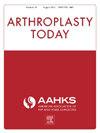Evaluating the Disparate Use of Knee Arthroplasty Among Minorities Using Social Vulnerability Index
IF 2.1
Q3 ORTHOPEDICS
引用次数: 0
Abstract
Background
Total knee arthroplasty (TKA) is an effective treatment for advanced osteoarthritis, but disparities in its utilization exist, particularly by gender, race, socioeconomic status, and geography. Social determinants of health may contribute to these disparities. This study examines the relationship among the Social Vulnerability Index (SVI), a measure of social determinants of health, and the likelihood of receiving a surgeon's recommendation for TKA.
Methods
This prospective, observational study included 314 patients with primary knee osteoarthritis deemed “appropriate” for TKA based on the American Academy of Orthopaedic Surgeons Appropriate Use Criteria. Patients were recruited from 4 fellowship-trained arthroplasty surgeons at a single academic hospital in Chicago. The primary outcome was whether patients received a surgeon recommendation for TKA, analyzed in relation to their SVI. Bivariate and multivariable analyses were performed, adjusting for patient demographics, body mass index, Charlson Comorbidity Index, and surgeon factors.
Results
Of the 314 patients appropriate for TKA by Appropriate Use Criteria guidelines, 39.2% received a surgeon recommendation. Patients with lower SVI scores were more likely to receive a recommendation (0.6596 vs 0.7556, P = .284). Multivariable analysis showed that lower SVI scores were independently associated with higher odds of a surgeon recommendation (odds ratio [OR]: 0.705, P = .028), particularly in the subcategories of socioeconomic status (OR: 0.754, P = .034) and household characteristics (OR: 0.803, P = .049).
Conclusions
Lower SVI scores are associated with increased likelihood of receiving a TKA recommendation, highlighting the impact of social vulnerability on clinical decision-making and the need for further investigation into mitigating biases in surgical decisions.
利用社会脆弱性指数评价少数民族膝关节置换术的不同应用
背景:全膝关节置换术(TKA)是晚期骨关节炎的有效治疗方法,但其应用存在差异,特别是因性别、种族、社会经济地位和地理位置而异。健康的社会决定因素可能造成这些差异。本研究考察了社会脆弱性指数(SVI)(衡量健康的社会决定因素)与接受外科医生建议的TKA的可能性之间的关系。方法:这项前瞻性观察性研究纳入了314例原发性膝关节骨性关节炎患者,这些患者根据美国骨科医师学会的适当使用标准被认为“适合”进行TKA。患者从芝加哥一家学术医院的4名接受过奖学金培训的关节置换外科医生中招募。主要结果是患者是否接受外科医生推荐的TKA,并分析其SVI。进行了双变量和多变量分析,调整了患者人口统计学、体重指数、Charlson合并症指数和外科医生因素。结果314例患者中,39.2%的患者接受了外科医生的推荐。SVI评分较低的患者更有可能获得推荐(0.6596 vs 0.7556, P = 0.284)。多变量分析显示,较低的SVI评分与较高的推荐外科医生的几率独立相关(比值比[OR]: 0.705, P = 0.028),特别是在社会经济地位(OR: 0.754, P = 0.034)和家庭特征(OR: 0.803, P = 0.049)的子类别中。SVI评分越低,接受TKA推荐的可能性越大,这突出了社会脆弱性对临床决策的影响,需要进一步研究减轻手术决策中的偏见。
本文章由计算机程序翻译,如有差异,请以英文原文为准。
求助全文
约1分钟内获得全文
求助全文
来源期刊

Arthroplasty Today
Medicine-Surgery
CiteScore
2.90
自引率
0.00%
发文量
258
审稿时长
40 weeks
期刊介绍:
Arthroplasty Today is a companion journal to the Journal of Arthroplasty. The journal Arthroplasty Today brings together the clinical and scientific foundations for joint replacement of the hip and knee in an open-access, online format. Arthroplasty Today solicits manuscripts of the highest quality from all areas of scientific endeavor that relate to joint replacement or the treatment of its complications, including those dealing with patient outcomes, economic and policy issues, prosthetic design, biomechanics, biomaterials, and biologic response to arthroplasty. The journal focuses on case reports. It is the purpose of Arthroplasty Today to present material to practicing orthopaedic surgeons that will keep them abreast of developments in the field, prove useful in the care of patients, and aid in understanding the scientific foundation of this subspecialty area of joint replacement. The international members of the Editorial Board provide a worldwide perspective for the journal''s area of interest. Their participation ensures that each issue of Arthroplasty Today provides the reader with timely, peer-reviewed articles of the highest quality.
 求助内容:
求助内容: 应助结果提醒方式:
应助结果提醒方式:


